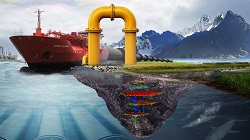Pilot case to speed carbon capture, transport and storage in Europe
CCS prevents large amounts of carbon dioxide (CO2) from fossil fuels entering the atmosphere. According to the International Energy Agency, CCS is the third-most important measure to limit global warming by two degrees Celsius. For many industries, CO2 capture is the only technology that can be retrofitted to existing assets to improve their carbon footprint. The limits to energy efficiency and electrification of industrial processes means that CO2 capture will be needed until new re-engineered processes and low-carbon materials are available to society. To meet the agreed longer term climate targets of an 80 %-95 % reduction in CO2 compared to 1990, CCS will remain a key mitigation solution across the industrial and power sectors. ‘The GATEWAY project demonstrates how to get CO2 from sources in Europe to a central storage in the North Sea in a simple, safe and cost-effective way,’ says Marie Bysveen, project coordinator for the EU-funded project GATEWAY(opens in new window). Getting the ball rolling on CCS deployment in Europe GATEWAY developed a business case for a potential Project of Common Interest (PCI). In doing so, it addressed risks, proposed measures for de-risking, assessed the technologies, policy and regulatory aspects, public perception and funding needs, and proposed possible financing mechanisms. These are key factors that can be applied to other similar projects and boost CCS development. ‘Industry and government will have at their disposal the first-of-its-kind available business case for a cross-border infrastructure for CO2 transport,’ explains Bysveen. Such efforts led to the submission of the Rotterdam Nucleus PCI application – GATEWAY’s most significant achievement. The PCI made it on to the European Commission’s priority list in October 2017. As Bysveen stresses, ‘This could be a pivotal step towards CCS deployment in Europe,’ stresses Bysveen. Rotterdam Nucleus will provide the basis for a high-volume CO2 transportation infrastructure system from mainland Europe to CO2 storage locations in the Dutch and United Kingdom sections of the North Sea. The infrastructure is designed to be over-sized, capable of providing CO2 transport capacity for pre-commercial and commercial phase CCS deployment in Rotterdam, as well as possible future links to industrial areas of third-party countries. Bysveen adds that the infrastructure ‘will have significant impact on the speed of CCS deployment in neighbouring countries, as the foundations for high-capacity CO2 transport and storage in the North Sea will be realised.’ Meeting the need for a CO2 transportation infrastructure in the North Sea Bysveen and project partners came to realise that coordination and support action projects can be extremely efficient and impactful. ‘Workshops and bilateral discussions with stakeholders have strongly contributed to a mutual understanding of both challenges and viable solutions related to cross-border infrastructure for CO2 transport to be developed in the North Sea region.’ Rotterdam Nucleus’ official status as a PCI project is important for work towards planning the actual construction of a CO2 infrastructure in the region. This helps to provide accelerated permitting procedures, improved regulatory conditions and possibly eligibility for financial support from the Connecting Europe Facility. ‘GATEWAY is paving the way for real CCS deployment on the European continent in the near future,’ concludes Bysveen. ‘It also laid the foundation for a high-volume infrastructure system for the transportation of CO2 from mainland Europe to CO2 storage locations in the North Sea.’







